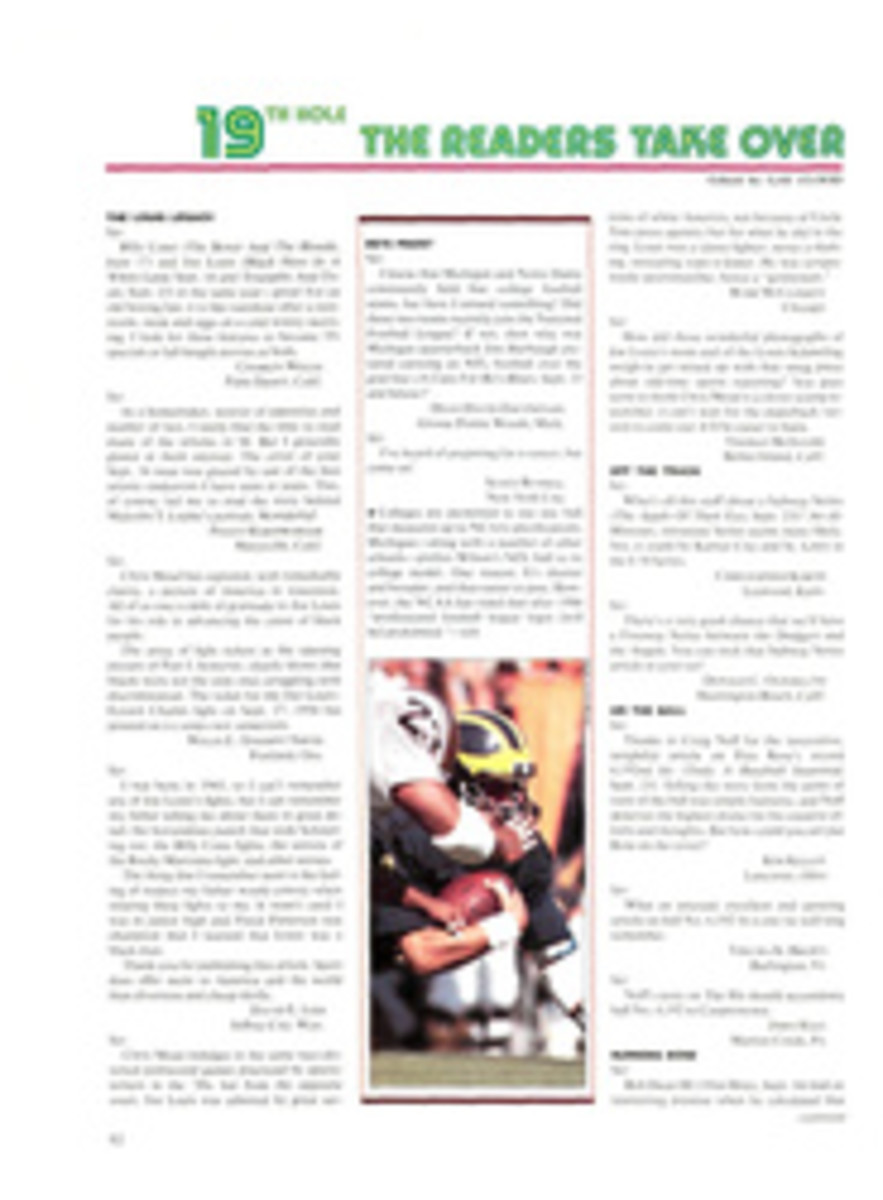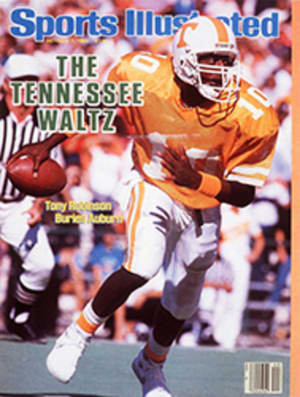
A Champ With Strange Ideas
It was an ambush, of sorts. Everyone thought Michael Spinks was a light heavyweight eating his way up to heavyweight. That's why there were all those gasps when Spinks weighed in at 200 pounds before his fight with heavyweight champion Larry Holmes. And that's why the assembled experts said the poor lad might just as well be packing a knapsack full of 25 pounds of rocks.
But not until Spinks had beaten Holmes, becoming the first light heavyweight champion to topple a reigning heavyweight king, was it revealed that his walking-around weight—the pounds he carries between fights—has been 187 to 192 pounds. No one suspected that all along Spinks had been a heavyweight pretending to be a light heavyweight.
Nor was there any flab in that walking-around poundage. On the contrary, Mackie Shilstone, Spinks's conditioning coach since 1982, estimates Spinks's normal body fat to be about 9%. When one considers that the average National Football League quarterback carries 11% to 12% body fat, it is easy to see that Spinks on vacation is a leaner specimen than most guys facing a Lawrence Taylor blitz. And, at 6'2½", he is just as big.
"You can't keep the guy out of the gym," Butch Lewis, the champion's promoter, adviser and close friend, says, explaining his man's trimness. "He just likes it."
When Spinks fought as a light heavy, it was Shilstone's assignment before fights to trim 20 to 25 pounds to get Spinks below the division's 175-pound limit. "Since he was already mostly muscle, that meant we had to get him down without sacrificing strength and stamina," says Shilstone.
In his next-to-last light heavyweight title defense, against David Sears on Feb. 23, Spinks came in at 170½ pounds, his lowest weight since winning a gold medal as a middleweight in the 1976 Olympics. His body fat was only 4.6%, which is lower than that of most Olympic marathoners.
"He had dropped 25 pounds, and the last eight or nine were pure muscle," says Shilstone, 34, a former 143-pound wide receiver at Tulane. Shilstone holds two master's degrees: one in nutrition, the other in business administration. "The press all said Michael had dried out all night and was in trouble. What they didn't know was that we had made the weight two days before the fight; that we were eating three meals a day and training twice a day while holding the weight without sacrificing energy."
In the third round, Spinks hit Sears with a right hand that lifted his rival off the floor and dropped him. Soon after that, the referee stopped the bout.
For the Holmes fight, Shilstone was told to draw up a new blueprint for the same body. This time he had to bring out the legitimate heavyweight in Spinks. When Spinks arrived in New Orleans—where Shilstone is a consultant to the Azar Foundation, a private medical research organization—eight weeks before the fight, he weighed 193 pounds, of which 9.1% was body fat. For the fight, Shilstone projected a weight of between 198 and 203 pounds, with 7.1% body fat.
"In that range, Michael would not sacrifice any explosiveness or speed and actually would be a more efficient fighter, even more than he was as a light heavyweight," says Shilstone. "A mistake [Holmes's camp] made was a critical one: They assumed Michael's walking-around weight was the same as his light heavyweight fighting weight. That was a major mistake."
When Spinks started training, Shilstone put him on a revolutionary regimen. Traditionally, a fighter runs long distances, anywhere from two to 10 miles, usually first thing in the morning. That, says Shilstone, "makes sense if you are trying to burn calories, to make weight." But there is no weight limit in the heavyweight division, and "after a certain point in the run, he isn't getting any benefit. In fact, it is just the reverse. While in Vegas, someone told me Holmes was running six miles at a 10-minutes-a-mile pace. He was deconditioning. He was shortening and tightening and making his muscles inflexible; and at his weight it is tough on his body to do six miles."
Previously, in bringing Spinks down to 175 pounds, Shilstone had him run not a set distance such as six miles, but a set time. To duplicate fight conditions, he ordered 15 three-minute sets, with a one-minute rest between each. This time, Shilstone, shifting the emphasis from time to distance, decided that the 880-yard run was the perfect conditioner. "That was our mainstay for training," he said. "A run that would not break him down and make him lose weight, yet would condition him for the rigors of a fight."
An athlete's performance limitations are largely determined by his production of lactic acid. Anytime he becomes out of breath, begins to huff and puff, he is producing lactic acid. The arms become heavy, the legs slow, the reflexes dull. During the one-minute rest period between rounds, a fighter's lactic-acid level is reduced.
"So we had to train Michael's recovery system," says Shilstone. "We not only had to train him to fight for three minutes, but we had to train him to recover during the one minute of rest to pull the lactic acid out. I had to give him the ability to throw a great many punches—Spinks threw 612 in 15 rounds—and I had to give him the ability to recover. The problem is, you can eliminate 100 percent of the lactic-acid buildup only in three minutes. We didn't have that much time. We had only one minute between rounds. But you can get out 75 percent in one minute. So we set up our training mode to get the full 75 percent."
Shilstone set up this weekly schedule:
Monday: At 6:30 a.m. begin a light program of walking and jogging to pre-stretch the muscles. "No 'road' work," says Shilstone. "I knew a typical boxer's jogging would shorten and tighten Michael's muscles." Then a series of four 880s at 75% effort. Spinks usually ran them in 2:46. Then a series of four 440s, followed by explosive calisthenics, such as squat jumps and elevated push-ups.
Tuesday: Two miles of variations of 440s and 330s with 30-second rest periods. Then weight training with 30-to 50-pound dumbbells, curling and pressing, all done from a boxer's stance. "Which everybody said was wrong," said Shilstone, referring to trainers' traditional fears about their fighters' becoming "muscle-bound." "If anyone knows anything about weightlifters, they know that they are some of the most flexible guys if they do the full range of motion, which we did."
Wednesday: Rest.
Thursday: Running (880s and 440s) and weights.
Friday: Running (440s and 330s) and explosive calisthenics.
Saturday: Running (880s and 440s) and weights.
Sunday: Off. "Again, they said two days of rest were wrong," said Shilstone.
Shilstone also gave Spinks heavy daily doses of vitamins B, C and E. For breakfast Sprinks had three poached eggs, shredded wheat, wheat toast, tea and fruits, or oatmeal, wheat pancakes, tea and fruits. For lunch he had broiled fish, green vegetables, baked potato, wheat toast, salad with lemon juice and vinegar, fruit and hot tea. At 4:30 p.m. he did his regular boxing training at the gym. At 7:30, he had dinner, which was the same as lunch except that broiled chicken or turkey was substituted for the fish.
The meals provided 4,500 calories a day, and consisted of 65% complex carbohydrates (from the fruits, vegetables and whole grains), 20% protein (mostly from the meat and fish) and 15% fats.
"When we left New Orleans on Aug. 29, Michael weighed 200 pounds," Shilstone said. "That's exactly what he was at the weigh-in. Three-and-one-half weeks before the fight, he was at his fighting weight. He had added more than six pounds while reducing his body fat to 7.2%. That is why everyone thought he still looked like a light heavy."
The question is: After Spinks's upset of Holmes, are boxing's traditionalists reevaluating their training methods?
"Bull——," said Angelo Dundee, who has trained 10 world champions, including Muhammad Ali and Pinklon Thomas, the current WBC heavyweight king. "This is a one-shot deal. He licked the guy because he was ripe for pluckin'. I had a fighter, Ruben Castillo, mess around with a nutritionist. All it did was get him stopped by Juan LaPorte. But his manager lost 20 pounds. Nutrition sucks. Wind sprints suck too. And if I catch a fighter of mine near a weight room, he better be able to take a baseball bat to the head. If Spinks will fight Pinklon, I'll buy him all the fruits and wheat he can eat."
Gil Clancy, now a CBS boxing commentator, trained fighters for 30 years. His best was Emile Griffith, who won world championships as a welterweight and a middleweight. "I don't think Spinks revolutionized anything," said Clancy. "You know how they rate performances for football teams? The offense gets a B; the defense gets a C minus. Well, Spinks was a C fighter who beat a D fighter. He won because the other guy was worse. Holmes was so bad, and Michael was wandering around in there like a giraffe. All that stuff might be good ideas, but not off that performance."
You can bet, though, that a lot of fighters will be studying Michael Spinks's novel training methods. And maybe try to beat his 880 time.
PHOTO
MANNY MILLAN
Others may scoff, but wheat, fruit, weightlifting and 880s were O.K. with Spinks.
PHOTO
JERRY LODRIGUSS
Shilstone made the menus and devised the workouts that put more muscle on Michael.
PHOTO
RICHARD MACKSON
With his constant movement and surprising strength, Spinks kept Holmes off balance.

